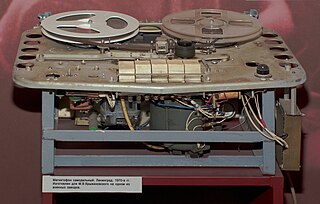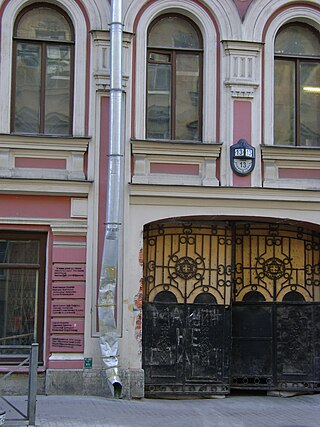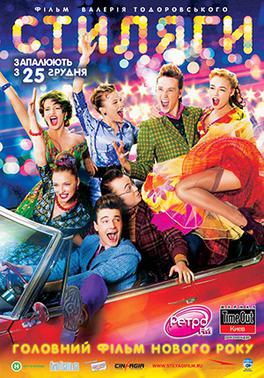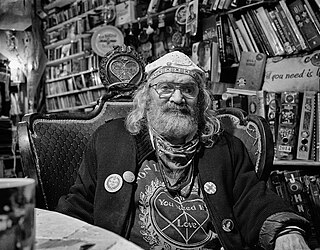
Walter Ernst Paul Ulbricht was a German communist politician. Ulbricht played a leading role in the creation of the Weimar-era Communist Party of Germany (KPD) and later in the early development and establishment of the German Democratic Republic. As the First Secretary of the Socialist Unity Party from 1950 to 1971, he was the chief decision-maker in East Germany. From President Wilhelm Pieck's death in 1960 on, he was also the East German head of state until his own death in 1973. As the leader of a significant Communist satellite, Ulbricht had a degree of bargaining power with the Kremlin that he used effectively. For example, he demanded the building of the Berlin Wall in 1961 when the Kremlin was reluctant.

Viktor Robertovich Tsoi was a Soviet singer-songwriter and actor who co-founded Kino, one of the most popular and musically influential bands in the history of Russian music.

Mashina Vremeni is a Russian rock band founded in 1969. Mashina Vremeni was a pioneer of Soviet rock music and remains one of the oldest still-active rock bands in Russia. The band's music incorporates elements of classic rock, blues, and bard's song. Mashina Vremeni's best known members are Andrey Makarevich, Alexander Kutikov, and Evgeny Margulis (guitarist/songwriter).
James Leslie John Woodhead, OBE is a British documentary filmmaker.
Timothy W. Ryback is a historian and director of the Institute for Historical Justice and Reconciliation in The Hague. He previously served as the Deputy-Secretary General of the Académie Diplomatique Internationale in Paris, and Director and Vice President of the Salzburg Global Seminar. Prior to this, he was a lecturer in the Concentration of History and Literature at Harvard University. Ryback has a doctorate.

Pankow are a German rock band, founded in East Berlin in 1981. Their name came from the Berlin district of Pankow, which was once home to most of the officials of the East German government. The band's original lineup consisted of Jürgen Ehle, André Herzberg, Rainer Kirchmann, Jäcki Reznicek and Frank Hille. Other members were Stefan Dohanetz, Ingo York and Jens Jensen.

Magnitizdat was the process of copying and distributing audio tape recordings that were not commercially available in the Soviet Union. It is analogous to samizdat, the method of disseminating written works that could not be officially published under Soviet political censorship. It is technically similar to bootleg recordings, except it has a political dimension not usually present in the latter term.

The time period of around 1985–1991 marked the final period of the Cold War. It was characterized by systemic reform within the Soviet Union, the easing of geopolitical tensions between the Soviet-led bloc and the United States-led bloc, the collapse of the Soviet Union's influence in Eastern Europe, and the dissolution of the Soviet Union in 1991.
Avtomaticheskie udovletvoriteli was a Soviet, and later Russian, punk band, formed in Leningrad in 1979. It is considered the first Russian punk band, and its founder, Andrei Panov, is sometimes referred to as "the first punk in the USSR".
Spring Rhythms: Tbilisi-80 was a musical event held in Tbilisi, capital of the Georgian SSR, Soviet Union, from March 8 to March 16, 1980. It was the first official rock festival in the Soviet Union and is frequently considered the turning point in the history of Soviet and Russian rock music.

The Leningrad Rock Club was a historic music venue of the 1980s in Leningrad, situated on Rubinstein Street in the city centre. Opened in 1981 and overseen by Komsomol and KGB, it became the first legal rock music venue in Leningrad. Overall, it was the largest rock scene in the Soviet Union and influenced the development of Russian rock.

The Leningrad Rock Club was a historic music venue of the 1980s in Leningrad, situated on Rubinstein Street in the city centre. Opened in 1981 and overseen by Komsomol and KGB, it became the first legal rock music venue in Leningrad. Overall, it was the largest rock scene in the Soviet Union and influenced the development of Russian rock.

Stilyagi is a 2008 Russian romantic jukebox musical film directed by Valery Todorovsky and starring Anton Shagin and Oksana Akinshina. Set in mid-1950s Moscow, the film depicts the Soviet stilyagi subculture, along with their struggle for self-expression within the prevailing reality of the Soviet repression.

Artemy Kivovich Troitsky is a Russian journalist, music critic, concert promoter, radio host, and academic who has lectured on music journalism at Moscow State University. In 1988, he was described in The New York Times as "the leading Soviet rock critic."

Ribs, also known as music on ribs, jazz on bones, bones or bone music (roentgenizdat), are improvised gramophone recordings made from X-ray films. Mostly made through the 1950s and 1960s, ribs were a black market method of smuggling in and distributing music that was banned from broadcast in the Soviet Union. Banned artists included emigre musicians, such as Pyotr Leshchenko and Alexander Vertinsky, and Western artists, such as Elvis, the Beatles, the Rolling Stones, the Beach Boys, Ella Fitzgerald and Chubby Checker.
Western culture influenced Soviet life and culture in many ways. From the 1950s until the 1980s this influence was manifested in a widespread fascination with Western manufactured goods, films, music, fashion and ideas. This fascination was condemned by the Soviet authorities and was described as "idol worshiping the West" and similar phrases.

Leto is a 2018 Russian musical film directed by Kirill Serebrennikov that depicts the Leningrad underground rock scene of the early 1980s. The film draws loosely from the lives of the Soviet rock musicians Viktor Tsoi and Mike Naumenko. It was selected to compete for the Palme d'Or at the 2018 Cannes Film Festival, where it won the Cannes Soundtrack Award. Leto also won the Best Production Designer at the 2018 European Film Awards.

Nikolai Ivanovich "Kolya" Vasin was a Russian music historian, writer, one of the main popularizers of the Beatles' creative work inside the USSR and Russia, collector who became prominent in the Soviet Union for collecting Beatles memorabilia.

Andrei Vladimirovich Tropillo was a Soviet and Russian record producer, music publisher, sound engineer, founder of the label AnTrop ("АнТроп"), and rock musician.
Mify are a rock band formed in Leningrad in 1966.

















